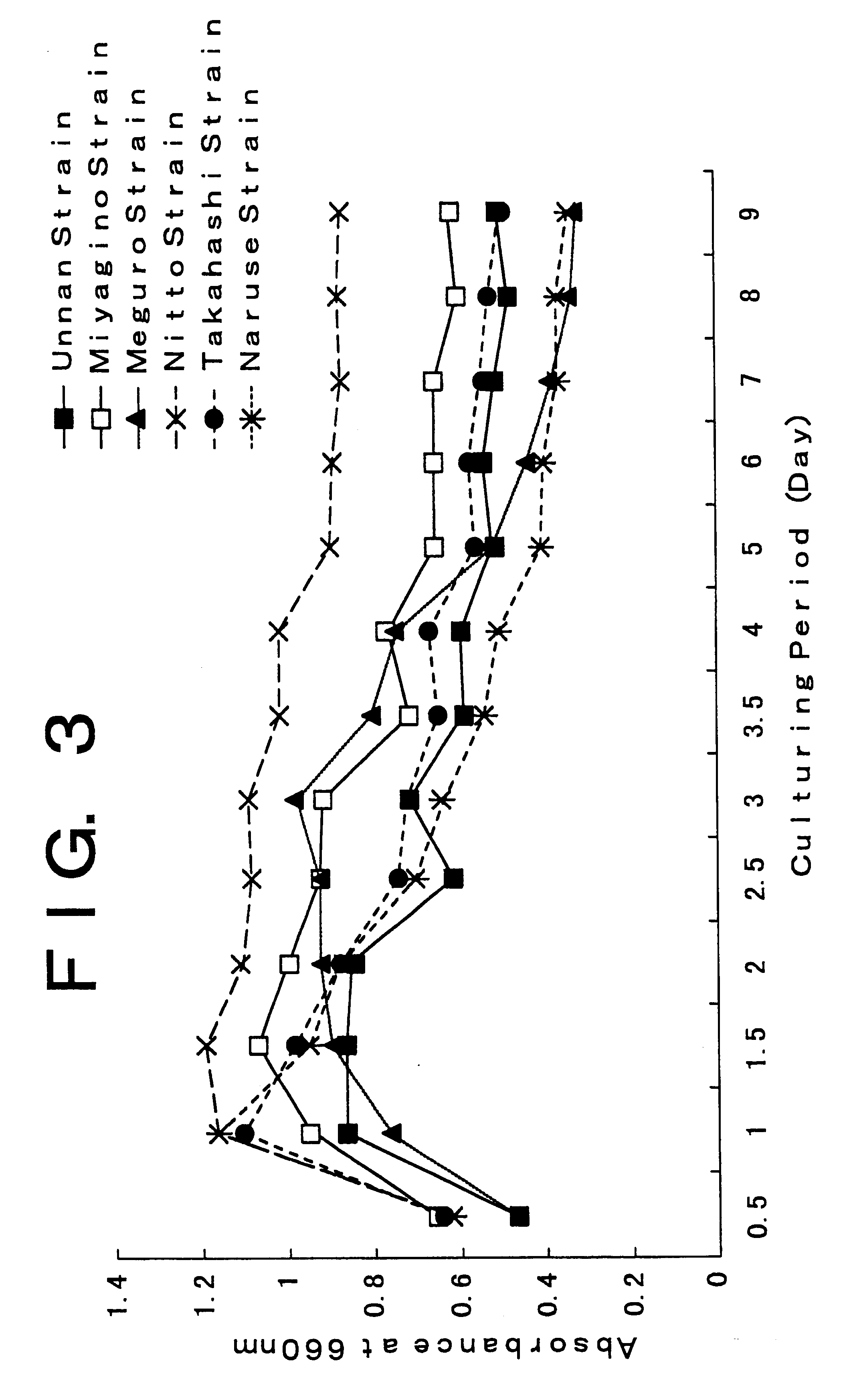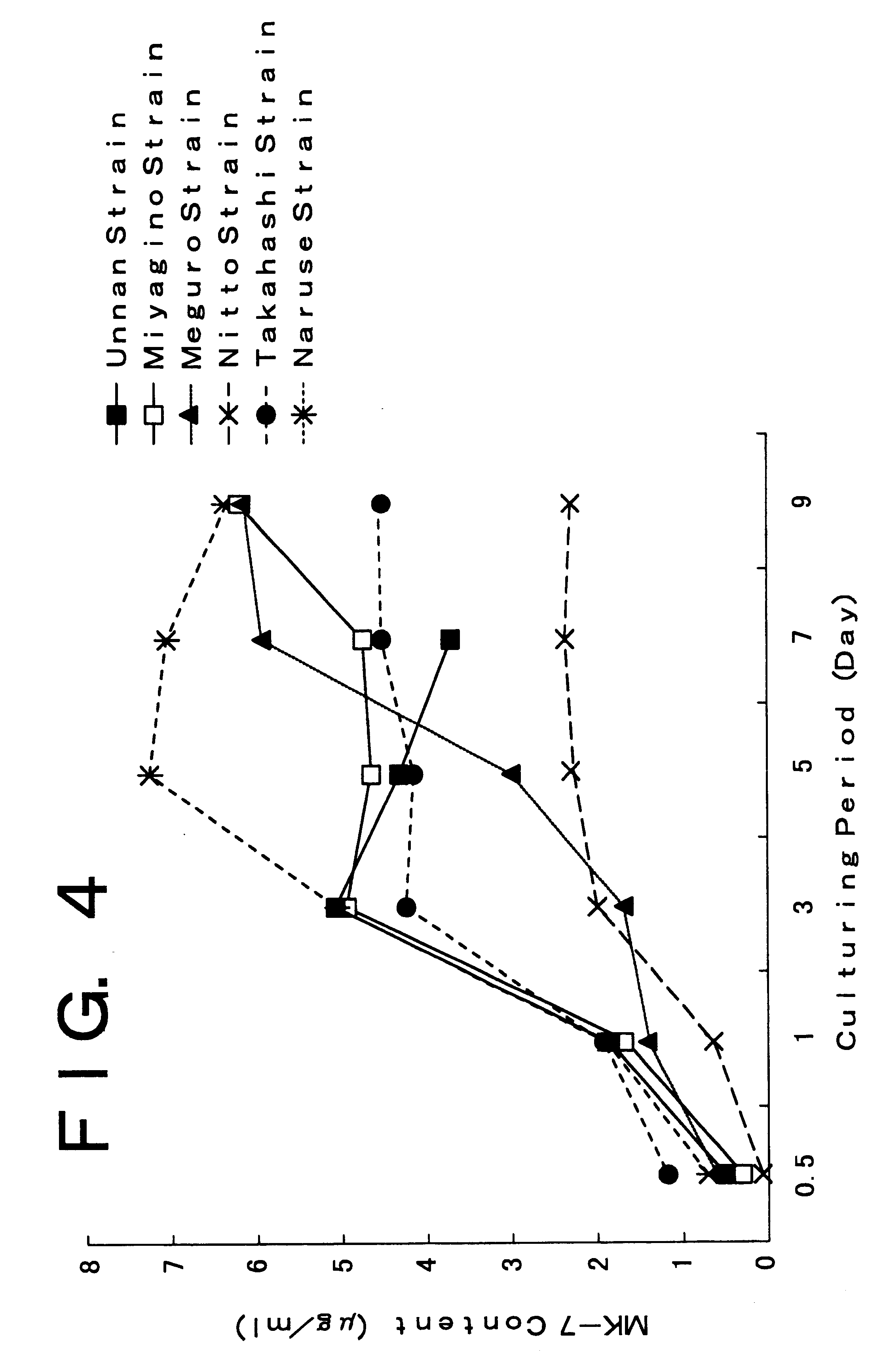Method for culturing Bacillus subtilis natto to produce water-soluble vitamin K and food product, beverage, or feed containing the cultured microorganism or the vitamin K derivative
a technology of bacillus subtilis and cultured microorganisms, applied in the field of methods, can solve the problems of posing a serious social problem, the ingestion of vitamin k in the dose mentioned above from existing food seems to be difficult, and the actual ingestion of vitamin k turns out to be a very difficult task
- Summary
- Abstract
- Description
- Claims
- Application Information
AI Technical Summary
Benefits of technology
Problems solved by technology
Method used
Image
Examples
example 2
Five healthy adults were each caused to ingest 1 g of dry cells (containing 1.8.times.10.sup.10 live cells) of Nitto strain (made by Nitto Yakuhin Kogyo K.K. in Kyoto) at 10 o'clock every morning. Then, blood was collected from the adults along the course of time. The plasma was separated from the collected blood and tested for MK-7 level in the plasma in the same manner as in Example 1. The results are shown in Table 1 and FIG. 2. The Bacillus subtilis natto used in the present example had a MK-7 content, as determined by the HPLC method, of about 51.0 .mu.g / g of dry cells.
As a control, five healthy adults were caused to ingest purified MK-7 in place of the dry cells of Bacillus subtilis natto mentioned above. The plasma similarly obtained from each of the healthy adults was tested for MK-7 level in the plasma. The results are shown in Table 1 below.
It is noted from the results shown in Table 1 and FIG. 2 that a significant acceleration of the MK-7 level in plasma reaching the peak...
example 3
The following six species of Bacillus subtilis natto were each shaking-cultured (100 rpm) at 30.degree. C. in 300 ml of a culture medium containing 3% nutrient broth (dry bouillon) (made by Nippon Seiyaku K.K.) and held in an Erlenmeyer flask, 500 ml in inner volume. The growth of the microorganic cells was determined in terms of absorbance at 660 nm and the amounts of MK-7 in the cultured broth and in the cells were measured at prescribed periods.
The growth of each species of Bacillus subtilis natto, the amount of MK-7 in the cultured broth (.mu.g / ml), and the amount of MK-7 per gram of the cells of each species of Bacillus subtilis natto (.mu.g / g) respectively relative to the culturing time are shown in FIG. 3, FIG. 4, and FIG. 5, respectively.
Unnan SL-001 Strain (otherwise called simply as "Unnan")
Miyagino strain (made by Miyagino Natto Manufactory K.K. in Sendai)
Meguro strain (made by Meguro Laboratory K.K. in Osaka)
Nitto strain (made by Nitto Yakuhin...
example 4
Bean-curd refuse (made by Asahimatsu Shokuhin K.K. in Iida-shi) was stored in a frozen state at -25.degree. C. and, when necessary, defrosted and put to use. The defrosted bean curd refuse was sterilized in an autoclave at 120.degree. C. for 30 minutes and placed in a container of polystyrene paper (PSP) having an inner volume of about 120 ml and used as a culture medium for Bacillus subtilis natto.
A total of seven species of Bacillus subtilis natto, i.e. four strains of Bacillus subtilis natto (Takahashi strain, Naruse strain, Miyagino strain, and Asahi strain) used in commercially available fermented soybeans, two strains of Bacillus subtilis natto (Nitto strain and Merugo) used in medicines, and a strain of Bacillus subtilis natto separated from the fermented soybeans from Unnan Province of China (Unnan SL-001 strain), were each shaking-cultured (100 rpm) at 37.degree. C. for three days in 150 ml of a culture medium containing 3% nutrient broth (made by Nippon Seiyaku K.K.) and h...
PUM
| Property | Measurement | Unit |
|---|---|---|
| temperature | aaaaa | aaaaa |
| temperature | aaaaa | aaaaa |
| water-solubility | aaaaa | aaaaa |
Abstract
Description
Claims
Application Information
 Login to View More
Login to View More - R&D
- Intellectual Property
- Life Sciences
- Materials
- Tech Scout
- Unparalleled Data Quality
- Higher Quality Content
- 60% Fewer Hallucinations
Browse by: Latest US Patents, China's latest patents, Technical Efficacy Thesaurus, Application Domain, Technology Topic, Popular Technical Reports.
© 2025 PatSnap. All rights reserved.Legal|Privacy policy|Modern Slavery Act Transparency Statement|Sitemap|About US| Contact US: help@patsnap.com



